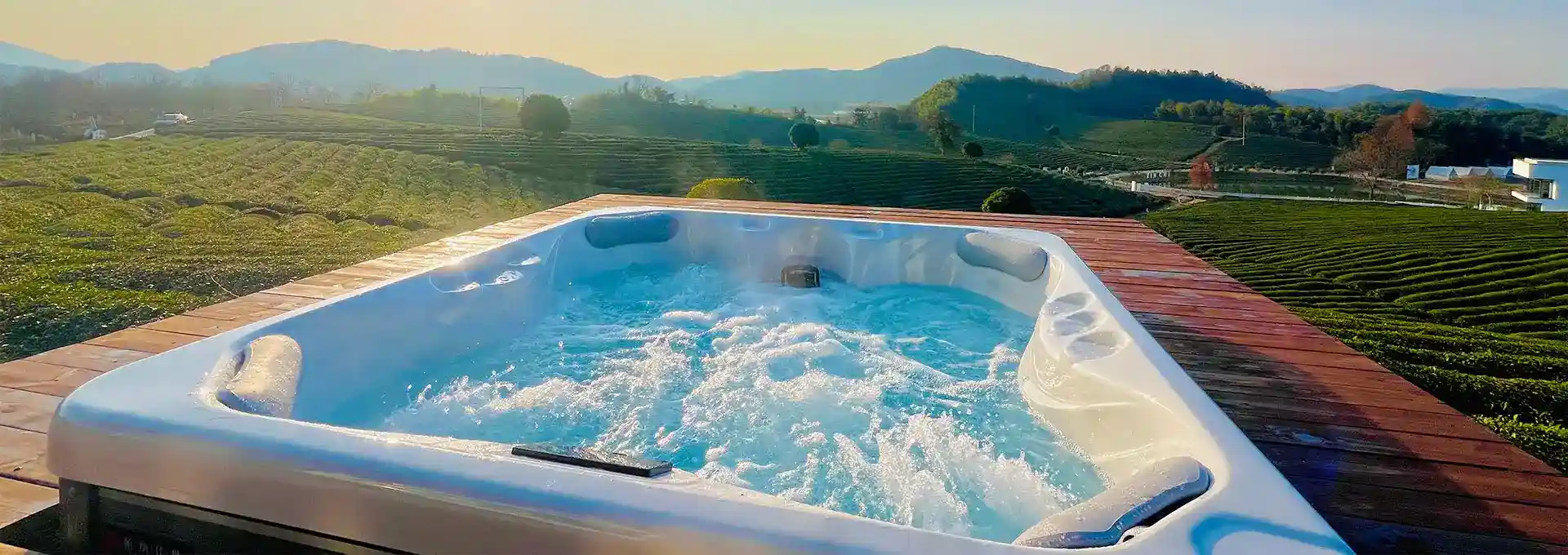How Many Gallons of Water in a Swim Spa?
2024-09-05 11:35:20
When considering adding a swim spa to your backyard oasis, one of the first questions that often comes to mind is, "How many gallons of water does a swim spa hold?" This is an important factor to consider, as it affects not only the initial setup but also ongoing maintenance and operating costs. Swim spas, which combine the benefits of a swimming pool and a hot tub, come in various sizes and configurations, making the water volume vary significantly from one model to another. In this blog post, we'll explore the typical water capacity of swim spas and delve into related questions that potential buyers frequently ask.
What is the average size of a backyard swim spa?
When it comes to backyard swim spas, size matters – not just for the space it occupies, but also for the swimming experience it provides. The average size of a backyard swim spa can vary depending on the manufacturer and intended use, but typically falls within a range that balances functionality with practicality.
Most residential swim spas measure between 12 to 19 feet in length, 7 to 8 feet in width, and 4 to 5 feet in depth. This size range accommodates various swimming styles and fitness activities while still fitting comfortably in many backyard settings. However, it's important to note that there are both smaller and larger options available to suit different needs and preferences.
Smaller swim spas, often referred to as "fitness spas" or "exercise spas," can be as compact as 10 feet in length. These are ideal for homeowners with limited outdoor space or those primarily interested in low-impact exercises and hydrotherapy. On the other end of the spectrum, larger swim spas can extend up to 21 feet or more in length, offering a more pool-like experience and potentially accommodating multiple users simultaneously.
The width of swim spas typically remains relatively consistent across different models, usually between 7 to 8 feet. This width provides enough space for comfortable swimming strokes while still being narrow enough to generate an effective current for swimming in place. The depth can vary but generally ranges from 4 to 5 feet, deep enough for most adults to swim comfortably without touching the bottom.
When considering the average size of a backyard swim spa, it's crucial to factor in the intended use. For instance, if the primary purpose is for serious swim training, a longer model might be preferable to allow for more extended swimming strokes. Conversely, if the swim spa will be used mainly for relaxation and light exercise, a smaller model might suffice.
It's also worth noting that the external dimensions of a swim spa are typically larger than its internal swimming area. This is due to the space required for the shell thickness, insulation, and equipment housing. When planning for installation, always consider the total external dimensions to ensure proper fit in your backyard space.
The average size of a backyard swim spa also impacts its water capacity, which brings us back to our main question about gallons of water. A swim spa in the 12 to 14-foot range typically holds between 1,500 to 2,000 gallons of water. Larger models in the 17 to 19-foot range can contain up to 2,500 to 3,000 gallons or more.
Understanding the average size of backyard swim spas is crucial not only for determining how it will fit in your outdoor space but also for estimating ongoing costs related to water usage, heating, and chemical treatments. It's always recommended to measure your available space carefully and consult with swim spa professionals to find the size that best suits your needs and lifestyle.
How much does it cost to fill a swim spa with water?
The cost of filling a swim spa with water is an important consideration for potential owners, as it impacts both the initial setup and ongoing maintenance expenses. Several factors influence this cost, including local water rates, the size of the swim spa, and any additional treatments required for the water.
To calculate the cost of filling a swim spa, you first need to know your local water rates. These can vary significantly depending on your location and water provider. In the United States, the average cost of water is around $1.50 per 1,000 gallons, but this can range from as low as $0.80 to over $3.00 per 1,000 gallons in some areas.
Let's consider a mid-sized swim spa that holds approximately 2,000 gallons of water. Using the average rate of $1.50 per 1,000 gallons, the basic cost to fill this swim spa would be about $3.00. However, this is just the starting point, and there are other factors to consider:
1. Initial fill vs. top-offs: The initial fill will be your largest water expense. After that, you'll only need to top off the spa periodically to account for evaporation and splash-out, which is typically much less costly.
2. Water treatment: You'll need to add chemicals to balance the pH and sanitize the water. The cost of these chemicals can vary, but you might expect to spend an additional $50 to $100 for the initial treatment.
3. Heating costs: While not directly related to filling the spa, it's worth noting that heating 2,000 gallons of water to your desired temperature will incur additional energy costs.
4. Frequency of water changes: Most manufacturers recommend changing the water in your swim spa every 3-4 months. This means you'll incur the filling cost several times a year.
5. Water delivery: If your home water supply isn't sufficient to fill the swim spa quickly, you might need to have water delivered, which can add to the cost.
It's also worth considering the long-term costs of water usage. While the initial fill might seem relatively inexpensive, the cumulative cost of regular top-offs and periodic complete water changes can add up over time. On average, you might expect to add about 1-2 inches of water per week due to evaporation, depending on your climate and usage patterns.
To minimize water-related costs, consider the following tips:
1. Use a well-fitting cover when the swim spa is not in use to reduce evaporation.
2. Maintain proper chemical balance to extend the life of your water between changes.
3. Consider a water recycling system that can filter and reuse water during changes.
4. Collect rainwater for top-offs, where permissible and practical.
5. Be mindful of splash-out during use, especially if children are using the swim spa.
While the cost to fill a swim spa with water is generally not prohibitive, it's an ongoing expense that should be factored into your budget when considering swim spa ownership. By understanding these costs and implementing water-saving strategies, you can enjoy your swim spa while managing expenses effectively.
How often should you change the water in a swim spa?
Maintaining clean and safe water in your swim spa is crucial for both the longevity of the equipment and the health of its users. One key aspect of this maintenance is knowing how often to change the water in your swim spa. While there's no one-size-fits-all answer, understanding the factors that influence water change frequency can help you establish an appropriate schedule for your specific situation.
Generally, most swim spa manufacturers and experts recommend changing the water every 3 to 4 months. However, this is just a guideline, and the actual frequency can vary based on several factors:
1. Usage frequency: The more often you use your swim spa, the more quickly the water will accumulate contaminants and require changing. Heavy use might necessitate more frequent water changes, possibly every 2-3 months.
2. Number of users: More people using the swim spa means more organic matter (sweat, oils, etc.) entering the water, which can lead to faster water degradation.
3. Environmental factors: Outdoor swim spas exposed to debris, sunlight, and varying weather conditions may require more frequent water changes than indoor ones.
4. Maintenance routine: Consistent and proper maintenance, including regular testing and balancing of water chemistry, can extend the time between water changes.
5. Water quality: If you start with hard water or water high in metals, you might need to change it more frequently.
6. Filtration system efficiency: A high-quality, well-maintained filtration system can help keep water clean longer, potentially extending the time between changes.
To determine if it's time to change your swim spa water, look out for these signs:
1. Cloudy or foamy water that doesn't clear up with proper chemical treatment
2. Difficulty maintaining proper pH and sanitizer levels
3. Unpleasant odors
4. Visible algae growth
5. Skin irritation or eye redness after use
It's important to note that while extending the time between water changes might seem cost-effective, it can lead to more significant issues in the long run. Old water can become a breeding ground for bacteria and algae, potentially damaging your swim spa's equipment and posing health risks to users.
When changing your swim spa water, follow these steps to ensure the process is efficient and effective:
1. Plan ahead: Choose a time when the swim spa won't be needed for at least a day.
2. Turn off the power: Always disconnect the electricity before draining to protect the pump and heating elements.
3. Drain the water: Use a submersible pump or the spa's drain valve. Direct the water to an appropriate drainage area, avoiding areas where it might cause flooding or damage to your property.
4. Clean the shell: Once empty, thoroughly clean the swim spa's interior surface with a non-abrasive cleaner designed for swim spas.
5. Clean or replace filters: Take this opportunity to deep clean your filters or replace them if necessary.
6. Refill with fresh water: Use a hose filter to prevent impurities from entering as you refill.
7. Balance the water: Add the necessary chemicals to achieve proper pH, alkalinity, and sanitizer levels.
8. Heat the water: Allow time for the water to reach your desired temperature before use.
Establishing a regular water change schedule, along with consistent daily and weekly maintenance, will help ensure that your swim spa remains a clean, safe, and enjoyable feature of your backyard swim spas. Remember, the goal is to maintain water quality while balancing the costs and effort associated with water changes. By paying attention to your swim spa's specific needs and adjusting your maintenance routine accordingly, you can optimize both the performance of your swim spa and your enjoyment of it.
If you want to get more information about this product, you can contact us at info@iparnassus.com!
References:
1. Swim University. (2021). How Often Should You Change Your Hot Tub Water?
2. Master Spas. (2022). Swim Spa Maintenance Guide.
3. Bullfrog Spas. (2023). How Much Does a Swim Spa Cost to Run?
4. Endless Pools. (2022). Swim Spa Sizing Guide.
5. Aqua Magazine. (2021). Water Chemistry Basics for Swim Spas. R
6. Energy.gov. (2023). Swimming Pool Covers.
7. Hot Spring Spas. (2022). How to Drain and Refill Your Hot Tub.
8. Swim Spa Source. (2023). Swim Spa Sizes: What You Need to Know.
9. EPA. (2022). Water Sense: Outdoor Water Use in the United States.
10. American Water Works Association. (2023). Water and Wastewater Rate Survey.



